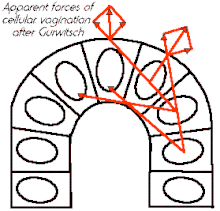
Back Camp morfogen (biologia del desenvolupament) Catalan Morfogenetické pole Czech Campo morfogenético (biología del desarrollo) Spanish Morfogenetisch veld Dutch Морфогенетичне поле Ukrainian

In the developmental biology of the early twentieth century, a morphogenetic field is a research hypothesis and a discrete region of cells in an embryo.[1][2]
The term morphogenetic field conceptualizes the scientific experimental finding that an embryonic group of cells, for example a forelimb bud, could be transplanted to another part of the embryo and in ongoing individual development still give rise to a forelimb at an odd place of the organism. And it describes a group of embryonic cells able to respond to localized biochemical signals − called field − leading to the genesis of morphological structures: tissues, organs, or parts of an organism.[3][4]
The spatial and temporal extents of such a region of embryonic stem cells are dynamic, and within it is a collection of interacting cells out of which a particular tissue, organ, or body part is formed.[5] As a group, the cells within a morphogenetic field in an embryo are constrained: thus, cells in a limb field will become a limb tissue, those in a heart field will become heart tissue.[6] Individual cells within a morphogenetic field in an embryo are flexible: thus, cells in a cardiac field can be redirected via cell-to-cell signaling to replace damaged or missing cells.[6]
The Imaginal disc in larvae is an example of a discrete morphogenetic field region of cells in an insect embryo.[7]
- ^ Cite error: The named reference
Beloussov_1997was invoked but never defined (see the help page). - ^ Cite error: The named reference
CGWwas invoked but never defined (see the help page). - ^ Alberts B, Johnson A, Lewis J, Raff M, Roberts K, Walter P (2002). Universal Mechanisms of Animal Development. in: Molecular Biology of the Cell (4th ed.). Garland. ISBN 978-0-8153-3218-3.
- ^ Jacobson AG, Sater AK (1 November 1988). "Features of embryonic induction". Development. 104 (3): 341–59. doi:10.1242/dev.104.3.341. PMID 3076860.
- ^ Gilbert SF, Opitz JM, Raff RA (1996). "Resynthesizing evolutionary and developmental biology". Dev. Biol. 173 (2): 357–72. doi:10.1006/dbio.1996.0032. PMID 8605997.
- ^ a b Gilbert SF (2003). Developmental biology (7th ed.). Sunderland, Mass: Sinauer Associates. pp. 65–6. ISBN 978-0-87893-258-0.
- ^ Alberts B, et al. (2002). Organogenesis and the Patterning of Appendages. in: Molecular Biology of the Cell (4th ed.). Garland. ISBN 978-0-8153-3218-3.
© MMXXIII Rich X Search. We shall prevail. All rights reserved. Rich X Search